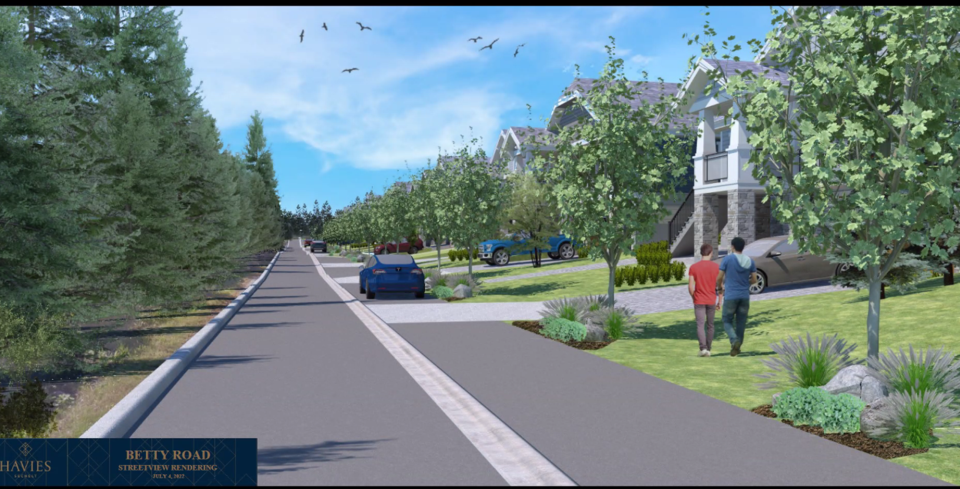With one councillor in opposition, Sechelt council has approved the development permit for the Havies subdivision proposed for Laurel Avenue at its Aug. 3 meeting.
The Homei Group’s proposal includes 99 units of three, five or six-bedroom single-family homes, although laneway homes could be added through zoning bylaw amendments. Design upgrades, landscaping and streetscaping were briefly presented to council, after the project received feedback from two meetings with the advisory planning commission (APC). Those design features are about 98 per cent done, the proponents said during the Aug. 3 meeting.
When Coun. Alton Toth questioned whether the developer considered townhomes or other options for housing stock rather than single-family homes, Sechelt development planning manager Ian Holl said the property is designated as low-density residential and that the existing zoning has been single family residential since 1987. Toth then asked why, with the recently approved addition of sewer service to the area, more density was not considered. Jurek Janota-Bzowski, of JB Coast Consulting Inc., said the proposal was increased from 67 to 99 units.
Coun. Tom Lamb asked about access to the highway, to which Holl said was still to be addressed, but Nestman Road will likely be the main access to the subdivison.
Toth voted in opposition to granting the development permit.
After the decision came down, a director of the Davis Bay-Wilson Creek-Selma Park Community Association, Katie Clogg, wrote a letter to council. She said the Aug. 3 meeting had been council’s first opportunity to speak to the project, and the community association has yet to have consultation with the district.
“We do find this alarming that the Planning Department's processes do not incorporate the feedback of neighbourhoods in a meaningful way,” she wrote. “By meaningful engagement, we mean some in-person discussion with our association members about how this development will change the nature of our community, traffic safety and planning, and what the long-term implications are for taxpayers who will be paying for services to maintain this huge development.”
Clogg said the community association members do not want the level of development the 99-unit subdivision would bring. At an APC meeting in June, Holl said that previous applications under the same development permit area (DPA) have been smaller in scale. Clogg also outlined some concerns, including traffic safety, particularly the increase of vehicles, how narrow Havies Road is, and the impact two new subdivisions (work is now under way on shíshálh Nation’s subdivision near Selma Park) in the area could have on the highway. Other items Clogg’s letter touched on were implications to water and sewage infrastructure, and the marketing of the Havies.
A video promoting the development makes several inaccurate claims about the Sunshine Coast, including that the Sunshine Coast had the best mineral alkaline water in the world in 2005. The Town of Gibsons received that award — Sechelt, where the development is located, uses a different water system. (As the video comments on water quality, one of the waterfalls shown is actually located in Costa Rica’s Tenorio Volcano National Park.)
When it talks about community amenities, the video shows a shopping centre with an escalator — but there’s no such escalator on the Coast. In the background of the clip, at least one of the signs is in Russian. The video claims the Sunshine Coast is Canada’s cultural capital, and has the best air quality and weather in the world.
“This development will double the number of homes in the immediate area, and potentially quadruple the population of our small and quiet Davis Bay community,” Clogg wrote.
A full formal referral to external agencies has not occurred yet, Holl noted during the Aug. 3 meeting. Revision of the park and transportation is ongoing. The staff report in the meeting’s agenda states that the “review of development permit applications is restricted to consideration of guidelines and objectives in relation to the proposed development. The level of density or use of the land may not be regulated through the development permit process.”
While guidelines for two of the three development permit areas the project is in have been met, the third (DPA 8) requires council approval. Holl said by bringing the development permit to council, they hope to incorporate DPA guidelines from the beginning of the process, rather than during the servicing agreement review, in order to avoid requiring substantial changes to the subdivision plan later on — “But that doesn't mean that we can't still make or consider changes to the subdivision or future,” he said.
A public information meeting is not required, as it would be for rezoning, Holl said, and it’s up to the approving officer to decide whether there is a need or desire for engagement. Holl said he is considering holding a public information meeting to seek additional feedback from the public, but one hasn’t been scheduled yet. Based on the size of the subdivision, Holl said the planning staff has been getting questions and comments from the public. Clogg’s letter expressed the community association is willing to present to council when meetings resume in September.



